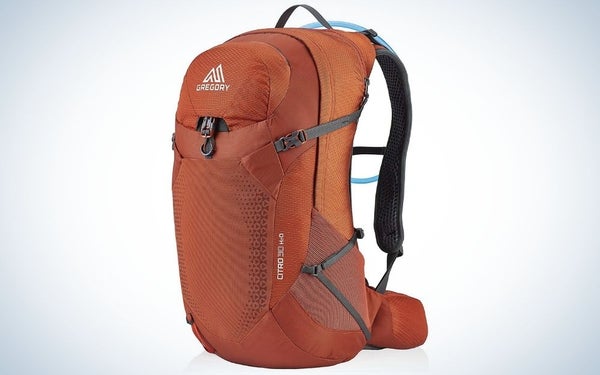



We may earn revenue from the products available on this page and participate in affiliate programs. Learn more ›
The best internal frame backpack is comfortable, lightweight, and functional. It effectively transfers weight from your shoulders onto your hips so it is easier to carry.
Internal frame backpacks are the most common type of wilderness pack sold these days. The internal frame means that there is a solid support on the inside of the pack, making it easier to carry. It’s lighter in weight than an external frame pack of the same size, yet it can still hold a lot of weight and gear.
With so many packs on the market, it can be overwhelming to find the right internal frame backpack for your needs. We examined numerous internal frame packs for size, weight, materials, and comfort. One of my top picks is bound to be right for you, whether you’re embarking on a day hike on local trails or planning a week-long expedition in the wilderness.
My experience choosing internal frame backpacks comes from many years in the backcountry and hundreds of miles hiked, both recreationally and as a guide. I’ve seen my fair share of good and bad internal frame backpacks, from hiking parts of the Appalachian Trail to guiding month-long expeditions. Over time, I tried dozens of packs myself and helped others navigate the sometimes overwhelming backpack market. I’ve personally suffered long backpacking trips due to a backpack that wasn’t right for me and have learned to look for the following characteristics:
Notice that durability was not one of the indicators used. This is because some of the most durable internal frame backpacks are made of heavy materials that add weight and limit breathability. If worn for long periods of time, I prefer to have a lighter and less durable pack and protect it when needed with liners and covers.
Why it Made the Cut: The Gregory Citro H2O (for men) and Juno H2O (essentially the same pack, designed for women) come in three volume capacities: 24, 30, and 36 liters. The 30-liter capacity is an all-around perfect size for a daypack. Combining comfort and utility, this is my pick for the best internal frame backpack for day hiking.
Key Features
Pros
Cons
Gregory has long been a leader in backpack technology, and it shouldn’t be a surprise that one of their models is my pick for the best internal frame backpack for day hiking. The Citro/June H20 is a comfortable daypack with various useful features that keep you moving, including its own hydration pouch.
The back design is made of breathable mesh, which greatly reduces back sweat, keeping you cooler and dryer. Adjustable hip and chest straps add comfort and support, ensuring the load don’t shift as you move. The hydration pouch valve has a magnetic attachment to the chest strap, so taking a sip won’t break your stride. An innovative harness secures your sunglasses right on the shoulder strap, and a hip belt pocket keeps snacks and other essentials at your fingertips.
All the convenient features come at a cost, and that’s weight. Although two pounds isn’t heavy, other daypacks can weigh half that, but often sacrifice comfort and utility.
Why it Made the Cut: The Osprey Atmos (men) and Aura (women) packs come in two capacities: 50 and 65 liters. The 65 L capacity is a versatile size for backpacking 2 to 7 days. With various size options, comfort, and functionality, this is my choice for the best internal frame backpack for camping and backpacking.
Key Features
Pros
Cons
Osprey is a leader in the backpack industry, and their 65 L Atmos/Aura pack is a perfect size for weekend to week-long treks. It’s also one of the most comfortable packs on the market, featuring Osprey’s “Anti-Gravity” system that provides comfort and ventilation thanks to a full-length mesh suspension system. The shoulder straps easily adjust for torso length, and the hip belt cinches and expands to fit most hips. Properly adjusted, even a 50-pound load is bearable.
The pack offers flexible storage, with a removable top lid that provides added storage when needed but can be ditched to shave ounces. A large, stretch-front mesh pocket swallows jackets and other outwear, so you don’t have to put wet clothes in your pack. The organization continues on the inside with zippered sleeping bag compartment on the bottom and a divider that removes to provide access to the rest of the pack. The shoulder straps feature a unique trekking pole attachment system, and you can find ice tool loops on the back. There is a sleeve for a hydration reservoir as well.
Loaded with all of these comfort features and padding, the Atmos/Aura weighs about four pounds. That’s light, but those that are weight-conscious might want to look for an alternative. Cost can be a concern as well, but the quality construction and top-shelf materials will stand the test of time.
Why it Made the Cut: Mystery Ranch sells high-quality load-bearing equipment for outdoorsmen, hunters, and the military. Their packs are some of the best in the biz. Because it has a very sturdy yet lightweight frame, the Mystery Ranch 2 Day Assault Backpack is my pick for the best internal frame tactical backpack.
Key Features
Pros
Cons
There is so much functional design in this pack. The three-zipper opening allows the user to “rip” open the top, or use the center zip to quickly and easily gain access to the middle of the pack. Inside the pack are multiple pockets, including space for a hydration reservoir and laptop. The padded sleeve fits laptops up to 15 inches and features a loop at the top for the days you want to swap your computer for a hydration sleeve.
With a full-length plastic frame sheet, Mystery Ranch’s fully adjustable Futura harness system, and a removable waistbelt, the pack remains comfortable even stuffed with a couple days’ worth of gear. The exterior has two water bottle pockets, enough Molle webbing to attach plenty of accessories, and compression straps. You can even personalize the Assault Daypack with a piece of Velcro to attach your favorite patch.
Price is again an issue, with the Assault costing twice as much as some of its same-sized competitors. But you pay a premium for durability, and heavy-duty 500 denier Cordura constructing doesn’t come cheap.
Why it Made the Cut: TETON Sports makes reliable budget outdoor gear. The Scout 3400 internal frame backpack provides relative comfort and versatility for less than $100. This is my pick for the best budget internal frame backpack.
Key Features
Pros
Cons
TETON sports packs are a great solution for those looking for a comfortable and useful internal frame backpack with a less painful price tag. You wouldn’t want to tackle the Appalachian Trail wearing the Sports Scout 3400, but it makes a great starter pack.
The TETON Sports Scout 3400 internal frame backpack is one-size-fits-all but can be adjusted to fit your torso, waist, chest, and shoulders. Just don’t expect the same level of customization you’d find in a top-of-the-line pack. And sizing could be tricky for adults who don’t fit in average height and weight ranges.
It has some nice features, including a sleeping bag compartment, hydration sleeve, external gear pockets, and side and lower gear loops to attach gear externally. The included rainfly keeps contents dry when storms hit.
Note that snaps, straps, and zippers are more likely to break or loosen on budget packs. While this is a great choice for beginners, you probably shouldn’t expect it to last a lifetime.
From the space you require to fit all your gear to the various design options, it can be overwhelming to purchase a new backpack. Here is what you need to consider.
Do you need to carry a little or a lot? Most backpack brands list the internal storage volume of a pack in liters. Internal frame packs range from 10 to 100 liters in capacity. Here’s a breakdown of the storage space you should choose based on your needs:
Backpack bodies are designed to fit the needs of hikers. However, keep in mind that any extra features will also add weight. Here are some key features to look for in an internal frame backpack:
Anyone who has shopped for a quality internal frame backpack knows that they aren’t cheap. With prices ranging from $50 to $500, it’s important to consider your needs before pulling the trigger on a purchase. Higher-priced backpacks often offer more variety in sizes and are composed of lightweight, high-tech materials. For some, the higher cost is worth it in order to shed pounds and add additional comfort.
Q: How much does an internal frame backpack cost?
Pricing varies widely based on the size of the backpack and the features it provides. Daypacks from respected hiking pack brands (Osprey, Gregory, Arcteryx, Deuter, and Kelty) start at over $100, and backpacking packs can get into the $400 range. These packs are built to be lightweight, comfortable, and used frequently over hundreds of miles. Budget brands can deliver a similar pack for half the price but will likely lack features and comfort.
Q: Can you carry-on an internal frame backpack?
It depends on the size. Most 15 to 40 L packs should meet requirements as a carry-on and fit in the overhead bin. The concern of checking a backpack of any kind is that loose straps can catch on items and hurt the pack. If you have to check a backpack, consider packing your filled backpack in a large duffel.
Q: Do people still use external frame packs?
External frame backpacks have been around a long time. Some people prefer this style of pack for its durability and functionality. Awkwardly shaped items sometimes don’t fit well inside or onto internal frame packs, so hunters, for example, might prefer the external frame to carry a rifle or bow against the exterior frame. Internal frame packs are generally lighter and more comfortable than external frame packs, yet they can still carry the same weight.
The best choice for an internal frame backpack depends on how much space you need. Write out what you’ll be taking or, better, gather it and take some measurements (and see the “Space” section above). Then, look carefully at the features of the packs you’re considering to see if they will be truly useful for you.





